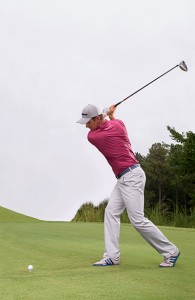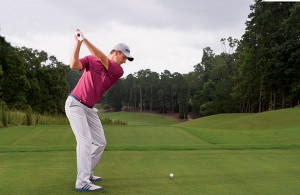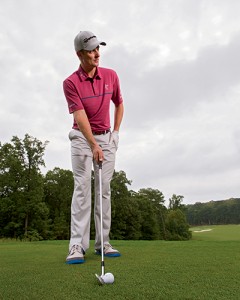How To Boost Your Power and Accuracy
I finished 2014 ranked fourth in a new stat called ‘Strokes Gained: Tee to Green’. It measures performance versus the field in everything but putting. For tour players, that really means driving and approach shots. Here’s what I think about when I’m driving the ball well and hitting greens.
OFF THE TEE
The most important part of my driver swing is generating power from the connection between my feet and the ground. It starts with a good setup. I play the ball up in my stance, because you need to catch it on the upswing with the driver if you want distance. I get into a good, athletic posture, and from there I start my swing.
The one-piece takeaway is a thing of the past. I think of it in pieces: the clubhead goes first, then the hands, then the arms. I turn into my right side, loading my right hip and engaging my glutes [below], similar to doing squats or deadlifts. That feeling of loading my right leg is a huge key for me.
Throughout the backswing, I’m thinking of the word develop. I’m not rushing to the top. I’m letting the swing develop in its own time. That helps me sync everything. At the top, when all my weight is loaded into my right side, I feel like my right big toe is pressing into the ground. I’m building as much leverage as possible from the ground up.
That sets up my move back to the ball. The key moment of my downswing is when I’m halfway down. There, I’m focused on storing power and maintaining my height. I keep up the pressure into the ground through my feet. With all that leverage, I can push off and release the club powerfully into the ball. If I’ve stayed in the shot and kept my connection to the ground, I’m ripping it down the middle.
Driver Practice
Here’s a drill I use for building power out of the ground. I drop my left foot back and put 90 per cent of my weight on my right foot. Then I bring my arms to the top and practise swinging halfway down. My weight doesn’t move off my right side, so my right leg is constantly engaged [below]. Repeating this motion helps me feel explosive into the ball, just what I want with the driver.
Once the ball is in the fairway, it’s time to put a good swing on my approach shot to get a look at birdie. Although the basic mechanics of the iron swing are similar to the driver, there are some differences. Namely, you want to hit down instead of hitting up. Here’s what I do on my iron shots:
TO THE GREEN
My ball position with the irons is farther back than with my driver, but it’s still forward of centre. Moving the ball back like this naturally puts more weight on my front foot, so I’m more over the ball. That’s a classic iron position.
In the takeaway, I think about having good width, but my arms don’t travel as far as they do in a driver swing. I like to feel a nice, tight windup to the top, or a full body turn but with a shorter arm swing. Another key is to stay more centred, without much lateral movement. This makes it easier to keep all the parts in sync.
As with the driver, a good key is to feel your weight load into your right leg. But make sure the pressure stays on the instep of your right foot. If you shift to the outside, you move off the ball, and that makes it tough to get back at impact.
When I swing down, I feel as if I’m leading the clubhead with my hands until just before impact. I know I’ve hit it well when my left arm feels real solid at the low point of the swing. (The low point is just past impact, at the end of the divot.) In the photo at far left, you can see how my left arm and the club are in line as the ball launches off the face.
Iron Practice
The position of the clubface at impact dictates where the ball starts, and it begins with the setup. I try to go with clear targets – If there’s a distinctive tree 2 metres left of the flag, that’s the exact direction in which I’m aiming.
To aim, I draw an imaginary line from my target to the ball [above]. Then I choose an intermediate target on that line 2m in front of me. I square the club to the shorter target, then take my stance. Practise that at the range, and make it part of your routine.







